Spaceships
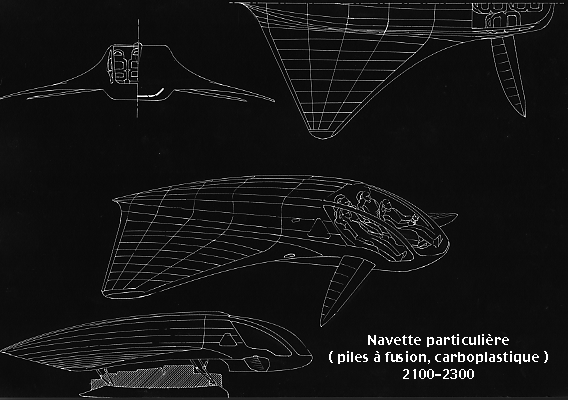 About Individual vessels 2100-2300 AD
About Individual vessels 2100-2300 ADThe natural evolution of the so-called "individual" vehicle must necessarily pass through magnetic levitation. However, the first to dispose of them had a weak repulsivity, and as a result they had to play on their lightness and the natural forces of the air generated by the speed, which spared the repulsive turbines. Totally non-polluting, producing a slight plasma, these aerated carboplastic shuttles weighed 25 Kgs the body alone, on a structure of 85 Kgs extruded tubes of alumiane, carrying 10 Kgs of seats and comfort equipment, and able to carry 4 (Below), and more than 200 Kgs of payload. They were, however, unfit for orbital exits, having to revert to repulsive corridors. At sea level their cruising speed was around Mach 3.2, allowing fast displacements in all weather thanks to the numerous assistances allowing automated piloting (4 passengers and a robot).
These beautiful machines spread by millions in the XXIIth, XXIIIth and XXVIth centuries began to decrease with the arrival of new repulsive turbines rendering deciduous their graceful bearing structure. However, the same materials were used to design individual or transit transport barges, with less ground support but still a light weight.
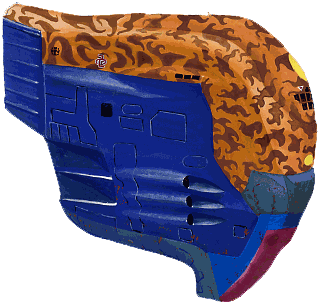 About Limchan ships
About Limchan shipsWar was never banished from the hearts of men, it was part of its profound nature, and was revealed in the neoprims as well as the most fervent expansionists. On Venus, there were brawls degenerating walls into real wars arranged between the different states. (See chapter on Venus, civilizations). With the increasing complexity of the confrontations, it was possible to develop combat vessels adapted to both atmospheric and spatial environments. The military naves of Curragh type (below) were chartered by the Limchans against the Nusinians in 4617-4622, then again in 4634-4638. They were real beasts of burden, adapted both to heavy combat (six concussion guns on the flanks), and to transporting troops (250 men and their equipment). They used a Hyaden-Jidsaa-type repeller turbine, well known for their force field exerting more effectively on a bevel shape, which explains the particular slice of this type of vessel, rather vertical.
They are camouflaged because operating in the desert, from pits summarily arranged, covered with a net. It is well known that when all the detection measures are countered by jammers, only the "visual" camouflage remains to do the same. The other color marks were intended for use in formations in space
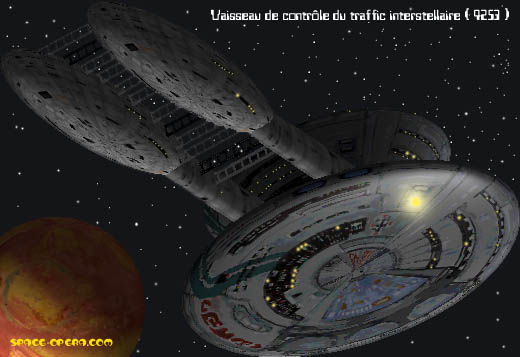 About traffic control ships
About traffic control shipsThese inter-star control vessels had a key role in monitoring hyperspatial roads. They were equipped to control the relays and doors, but could also travel inside to test them. In general, they followed the sending of drones at the inauguration of any new line, measuring possible gaps in magnetism, lateral diffraction effects, gravitational influences ... They issued the license to open a line to the public. They were 180 meters long, 50 inches wide, and offered their crew a very honorable living condition thanks to their gravity wheel integrated into the ship\'s structure.
Their successors will be much rudimentary, maneuvered by ungravid functions. These types of vessels disappear gradually with the appearance of the first supraluminic naves.
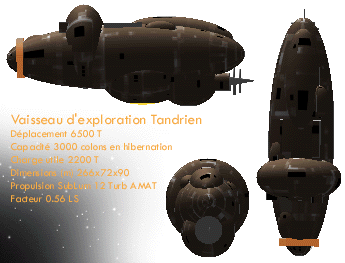 About Tandrian spaceships (2900 AD)
About Tandrian spaceships (2900 AD)The Tandrians, a people from the Dom world Tandria, located in the Shenandoah system, built a reputation as talented engineers for fast stellar exploration vessels. Being sent via a hyperspatial road and then to its own propellers in any new stellar system, they had enough holds for considerable material to land for any colony base, but also most of the detection, Geological and other studies, thanks in particular to its fleet of Chuzen communication probes. Due to the length of travel, these Tandrian Nerves carried their settlers in hibernation, at the rate of 300 to 800 according to the choices of modifications made by the consortium which commands them.
Very flexible, complete and affordable, these long units of 266 meters and moving 6500 tons have been a huge commercial success. From 3514 to 4520, more than 25,580 will be built, with hundreds of variants. One of them is currently still in orbit around Sullusian-2 (Crab Nebula), transformed into a museum.
 About Grinen Caravs (650 AD)
About Grinen Caravs (650 AD)How does a company such as the Grinens, which bases all their infrastructure on biological species and not assemblages, create its means of air transport? -It uses "caravs". These species halfway between the plant and the animal, like most Grinens species, are obviously symbiotic, designed to carry its passengers (up to 12) in its front pocket, which has openings, Closed by parasitic algae replacing the glass. The Caraves have a very flexible and light bioanimal skeleton, as well as balloons large enough to charge the natural methane that it produces. The carave is indeed herbivorous, but consumes about twice a day, at around 600 Kgs. seaweed. It has neither sight nor odoraty, but like the bats, the thousands of "sound buds" on the body that interact with the environment. What is more, she receives her orders from a human Grinian "pilot", who is somehow his "mahout" for life, housed in a special room arranged just under his brain and connected to him by biophit extensions. There are about 360 species rescued, depending on geographical areas, and age, caraves change appearance and live up to 400 years, a benefit of genetic crosses. (See Grinen)
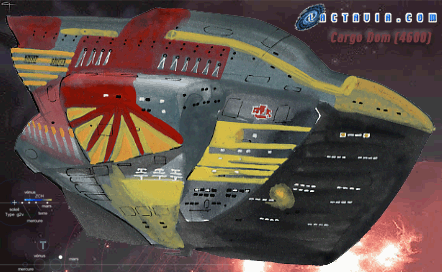 About Dom Freighters (5500 AD)
About Dom Freighters (5500 AD)The Doms possess the civilization which is certainly the most important of the expansionists, but also the most durable and the most heterogeneous. Serving the many Dom stars (90% of the Galaxy stars), cargo ships from the 5300s have shorter, stronger shapes not only to move through the hyperlite corridors, but also to land and take off from Cities Doms, but also of terraformed worlds with often higher gravity. The cargo below linked Canandaigua-2 to Chitah-4. It is 125 meters long and 82 meters high. It is known for its slim shapes, which can be explained by its use on hyperlite freighters, which take up to 500 on long distances (between 120 and 250 AL). As usual, their visual markings are as aesthetic as functional, intended to control units from commercial stations, orbital counters. Their crews are made up of a dozen Ungravids who live there with their families.
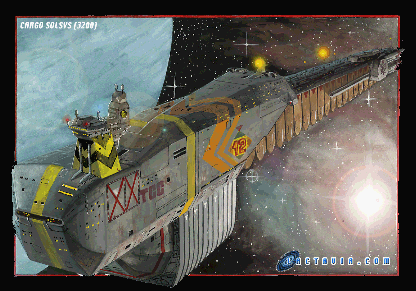 About solsys Freighters
About solsys FreightersSolsys has seen thousands of great ships like this pass through it. Below is the Heary Braggs, a bulk cargo ship of class J, the first examples of which were released in 2850. They are characterized by massive volumes and a separation between compartments. The front part, may contain freight, hibernating settlers, biological material, or valuable components. Below another hold carries the heavy iron-making equipment necessary to the colonial installations. Disassembled processors were able to take place, and these containers were directly satellited over a planet, where they crashed. The central part, the longest, contained the bulky tanks, but could also contain gas. All in the back were the skholium reserves, and the AMAT turbine. This gave him a factor of 0.0054 AL in cruise, enough to rally the Earth since Mars in 35 days. Length: 2,252 meters, width 82 meters, height 210 meters, displacement 850,000 tons empty. 12 men of crew, carrying capacity of 5000 colonists.
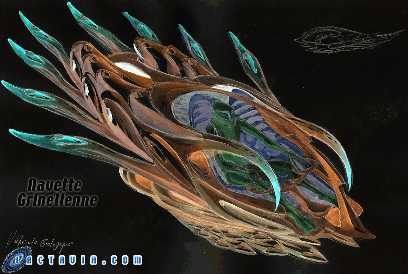 About Daliplang Grinnen crafts
About Daliplang Grinnen craftsThe Grinnians (or Grinellians, although the term is improperly used), travel on board caravans, admittedly spacious and majestic, but slow and precisely collective. The bioanimal organisms developed by Grinnens such as this individual shuttle feed on algae, live about 230 years (as much as the Grinnens). Their adult age corresponds to the moment when humans develop the ability to use them freely. Every child, Grinnen, receives his Daliplang (local name of this species) from his earliest age and learns how to maintain and nourish it, as well as to master it, through biophysical (biosynaptic) bonds. (See Grinen, civilizations). The "shuttle" feeds at the same time that it moves, since it does not possess balloons to sustain itself, it is a terrestrial species, equipped with more than 500 "paws", but also "remiges", large extensions Filled with billions of microneedles that proceed by nanomagnetism on their environment. In fact, these Daliplang move within the vast banks of Chazrannes, these microscopic aerial crustaceans, whose reduced weight and fins allow to constitute real "corridors" of living matter in continuous migration, forming so many networks.
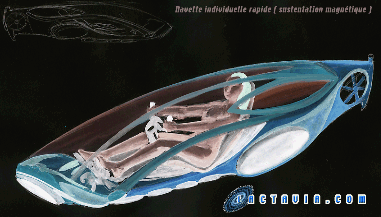 About SIS crafts
About SIS craftsThe standard individual shuttles (SIS) used by the Doms and the expansionists for nearly 8,000 years are the most rational and simplest means of transport, hence their record breaking. Each urban citizen of the federation, then empires, one day possessed one. Initially, it was a question of finding the ideal means of transport, adapted to the urban environment but sufficiently versatile to reach transcontinental speeds. Lightweight (carboplastic and internal structure of carbumin), and very well shaped, built from recycled materials, the only "heavy" part of its edge outside its conductor, is the fusion cell and the repellent tarsi. Many are also equipped with an anti-torque rotor. The first had a low speed and, above all, a low autonomy coupled with a lack of loud sustenance, and a hundred years later they were used as helicopters. They were used under innumerable variants until the end of the expansionist civilization. Length: 2.20 to 2.95 meters. Width 65 cm, weight 42 Kgs. Empty, payload 110 Kgs. Max speed 2200 Km / h, practical ceiling 20 meters, wear (components 6-30 years, structure 45 years).
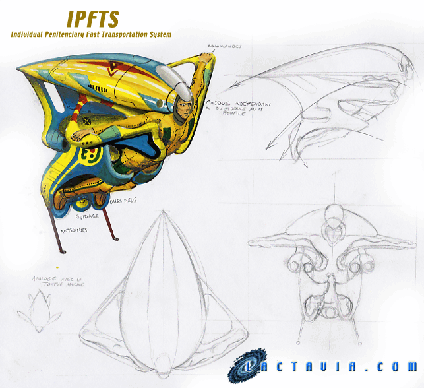 About IPFTS penitentiary transportation system
About IPFTS penitentiary transportation systemThis acronym stands for "Individual Penitenciary Fast Transportation System" in classic old standard. This is a rarity found only on a few very large (class IV) penitentiary areas. These machines are the only way for condemned to go from A to B but in its design is responsible for reminding them of their condition by the very uncomfortable position required to reach the joysticks. Although they were primitive machines, they were nevertheless "appropriate" by the inmates who painted them in bright colors and used them in racing. At the origin it was a failed concept that was "recycled" after a unpaid serie was done.
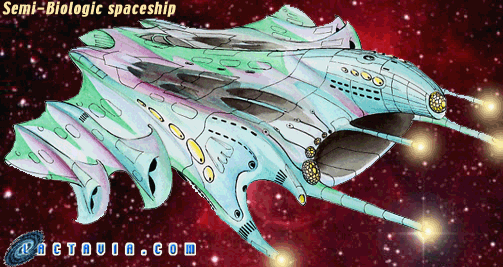 About grinnian spaceships
About grinnian spaceshipsThis singular spacecraft is one of the post-Grinian experiments (9000-10 000) able to combine specifically Grinian characters as a basic biological structure (biospaft, Reed\'gara), with a classical titanium the protected. Though sublite (sub-luminic), these living machines sustain themselves by "swallowing" and reconverting the icy material (clouds of methane microparticles) from the peripheral zones. They emit a propellant aluminothermic plasma, but have the immense advantage of being atmospheric, and "live" more than 2000 years. Dimensions: (L, W, H): 68x70x20 meters; 250 tonnes, 20 passengers or 30 tonnes of freight. (See Grinen, civilizations)
 About MTAC Hugues-25 Ashikagu (2300-2650)
About MTAC Hugues-25 Ashikagu (2300-2650)The helicopters of the 20th and 21st centuries had a definite disadvantage, that of consuming fossil fuels with limited efficiency, which was no longer acceptable to the environment. The principle was therefore revised, and the fusion cell developed for the automotive industry, as well as the already known but not yet adapted so-called "non-responding" systems, unlike the old captive systems, Would constitute the new means of sustenance of these machines. The Military Transport Assault Craft (MTAC) was a lift-assault craft capable of operating with high-efficiency turbines at altitudes up to 110 meters. The fact that they are equipped with inverted wings (for maneuverability), gave them a sustentation by the speed well served by a weight controlled at best considering the specifications: Shielding with titanium-Kevlar on the whole part Previous, offensive load 2500 Kgs. These were not troop movements but heavily armed fire support vehicles (rockets, missiles, fast guns). Dimensions: (L, W, H): 9.80 x 4.10 x 2.70 meters; Displacement 3200 Kgs. (Max 950 km / h)
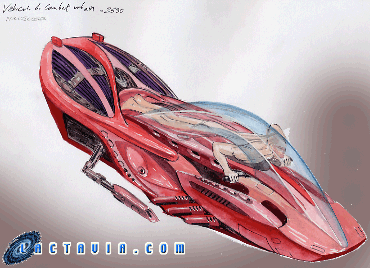 Urban Combat Shuttle-Ayrubath (5900-8500)
Urban Combat Shuttle-Ayrubath (5900-8500)These individual machines, powered by a fusion pile, were originally the improved Nucscoots, which were used for a long time in the shallows of Ayrubath, the most dangerous city in the federation, located in Spangell\'s asteroid The great barrier of the Tonite system, a high place of piracy. The underworld used these machines to move in an atmospheric environment, transformed to carry out better defended shuttle attacks. Agile, capable of hiding in the midst of the gigantic technical structures of the low-lying tower cities, they were the ideal type of vehicle to move safely in these big cities. They were built on the spot, but became a real fashion phenomenon and were replicated in many Giga-cities, including, of course.
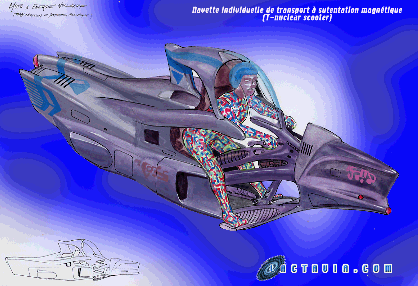 About Nuscoot (2200-2600)
About Nuscoot (2200-2600)Magnetic repulsion and nuvclear propulsion were applied in rapid trains in the 21st century. With the development of nanocarbon structures, and carboplastic, or metals as molecularly redefined as carbumin, one was able to build individual vehicles fast and reliable. The nuclear scooter (Nuksut, formerly a nucscoot) was the vein of these fast, resistant and enduring engines that could take its passenger to more than 600 km / h, and rise up to 2 meters. Subsequently this figure increased with the progress made in the yield of repulsive tarsi. They were very widespread until 2600, before the IFTS replaced them more advantageously. Dimensions: (L, W, H): 3.80x0.60x0.70 meters; Displacement 850 Kgs.
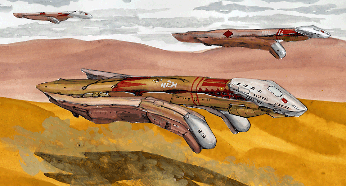 About Resandian Patoker (3300 AD)
About Resandian Patoker (3300 AD)The biped patrollers of the "patoker" type, used by many civilizations, were enormous machines equipped with obvious all-terrain capabilities added to the ability to "steal" through a repellent system. The variant used on Resander (Alpha Centauri) had much larger flight capabilities, especially to escape the sandstorms, which were formidable for the mechanisms of these engines. These Patokers carried typical assault weapons (fast-firing guns and rockets), but no accommodation capacity. Their two crewmen were widely assisted electronically. Dimensions: (L, W, H): 25 x 8.20 x 4 meters (22 "standing"); Moving 310 tons. (V. 2260 Kmh)
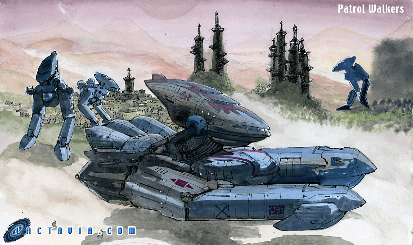 About Patokers
About PatokersThe Patokers (old-style Pat (rol) walkers) were semi-automated and heavy-duty craft capable of carrying out an assault on the ground and patrolling long distances without worrying about the terrain. They use a fusion cell coupled to an electric breaker. Their crew was 5 men. Extremely heavy in the genus (2850 tons), armored and largely equipped, they also had a very useful transformation capacity to "fly" by surface effect and repulsion, a few meters above any ground. They have sophisticated weapons systems, a small medical unit and can take 10 men with their equipment. In the race, they easily reach 160 km / h, and more than 1700 in flight. They were extensively used by land forces Doms.
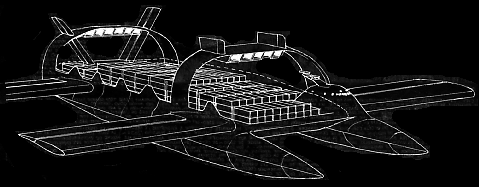 Abou Screplan Freighters
Abou Screplan FreightersAmong the oldest archives of this site, here are these hybrid engines used in maritime transport on sea, on Earth in the XXIIth century. Inspired by the machines built nearly two centuries earlier and abandoned for lack of cost-effective energy and the limits of the principle, subordinate to marine meteorology, the screenplane uses the surface effect to move it. It flies, but at the waves, a little in the manner of a hovercraft, but without "skirts" and therefore without compression. This one is a container ship, the Hinyan paradise, propelled by 11 ramjets. The take-off is done thanks to the blowers at the back of the hulls, fed by a compressor itself connected to a fusion cell. These "ships" have become very widespread due to the lack of drag and the large volumes carried, and above all thanks to the reliability of the weather forecasts and their ability to fly at 20 meters and 1280 km / h above the waves If necessary, they formed the large battalions of the classical maritime transport until 2150.
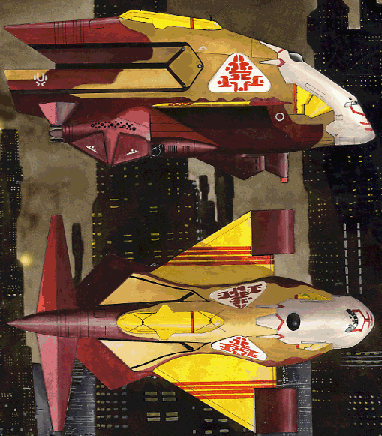 About the Tonite bear Subokhtan
About the Tonite bear SubokhtanAs durable as the Tonite heavy fighter, the Subokhtan (bear), was the standard assault transport of the Tonite forces. They served in a number of local engagements, notably against piracy, this new scourge that was right for the Colloded. Extremely solid and handy, adapted to the atmospheric and spatial environment at the same time, they also bore a "camouflage" doubled with sighted marks of recognition. They had, however, limited weapons to two lasers and two octopes conventional guns of 30 mm rotating rapid fire for the support to the ground. Dimensions: (L, W, H): 44x28x21 meters; Relocated 400 tons, carried 200 troops and 80 tons of cargo.
 About Tiburon Fighters
About Tiburon FightersAdapted to atmospheric and space combat, the Tiburon (F-52), are the favorite hunting units of the federal human forces for half a century. Modernized, they were embarked aboard the frigates, herself an integral part of the cruiser-mothers. It is estimated that more than 522,500 were built and assigned to the four stellar squadrons that the federation aligned in case of conflict. Their work was most often involved in commercial control, non-violation of sanctuaries, and the global maintenance of peace. They were, however, heavy and relatively complex, and were the victims of the Baarkan-led fighters during the war of 4042.
 Centauri
Centauri
 Grumiege
Grumiege
 Giesessen
Giesessen
 Rustofora
Rustofora
 Banastar
Banastar
 Paduca
Paduca
 Shenanda
Shenanda
 Sitansani
Sitansani
 Trecomsa
Trecomsa
 Eridani
Eridani